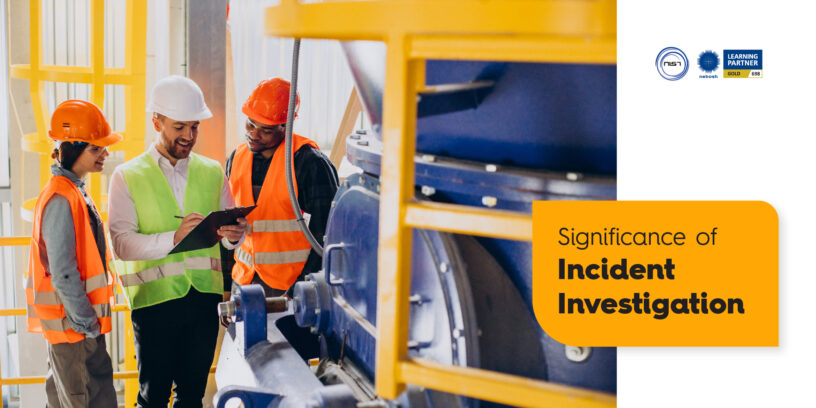Incident investigation is an essential procedure that aids organizations in determining the root causes of mishaps and putting policies in place to prevent repeat incidents. Here are 10 reasons why we should investigate into incidents :
1. Identify the root causes
It is essential to conduct a comprehensive investigation of every workplace incident in order to identify the root factors that contributed to the occurrence. It is challenging to stop such situations from occurring again without figuring out the root cause(s).
The process of investigating an occurrence comprises a methodical approach that includes information gathering, data analysis, and the identification of contributing elements. Understanding the cause of the occurrence and what can be done to stop it from happening again are the main objectives.
2. Ensure Worker’s Safety
To ensure the safety of employees, incidents and occurrences must be thoroughly investigated. Even with the best safety procedures in place, incidents can still occur at work. However, by looking into incidents and events, organizations can find potential risks and hazards that can be reduced or removed to stop such occurrences in the future.
3. To Learn
Investigating mishaps and disasters enables businesses to learn from the past and enhance future results. Analyzing an incident’s root causes and pinpointing possibilities for improvement are part of this process. Organizations can then take corrective action to stop similar occurrences from happening in the future.
For ongoing progress, learning from mistakes is crucial. Without looking into incidents and figuring out their root causes, organizations are likely to keep making the same mistakes, leading to ongoing safety mishaps, lost productivity, and significant legal liabilities.
4. Enhance Safety
To increase workplace safety, Incidents and occurrences must be thoroughly investigated. Organizations can identify areas where safety can be enhanced and take corrective action to stop similar incidents from happening in the future by analyzing the incident’s fundamental causes.
Investigating events may lead to the discovery of previously unnoticed or ignored safety risks. A near-miss occurrence, for instance, can highlight possible safety risks that weren’t previously recognized or addressed. Organizations can prevent such events from happening by examining near misses and identifying potential safety issues.
5. Comply with regulations
Regulations that mandate the investigation of incidents and occurrences apply to many different sectors. To prevent fines and legal penalties and to guarantee the security of both employees and visitors, compliance with these regulations is essential.
Organizations must conduct investigations into specific kinds of incidents and occurrences, such as those that cause major harm, disease, or death, according to regulatory bodies. Significant fines and penalties may be imposed for breaking these rules.
6. Risk Management
An essential component of risk management is the investigation of incidents and events. Organizations can identify possible risks and take proactive steps to reduce or eliminate them by understanding the root causes of incidents. The safety and wellbeing of staff members and guests can then be preserved, as well as help prevent further instances.
Assessing the likelihood and seriousness of prospective dangers is a component of risk management. Organizations can examine the efficiency of their current risk management systems and find dangers that may not have been previously detected by conducting investigations into occurrences. Making decisions about safety policies, practices, and financial investments in safety education and gear can be done with the help of this information.
7. Reduce Costs
Organizations may incur high costs as a result of incidents due to lost production, equipment damage, and medical costs. By determining the root causes of the occurrence and taking corrective action to avoid such incidents in the future, investigating these events can help reduce these expenses.
Organizations can lower the expenses related to lost productivity and damaged equipment by avoiding incidents from happening. Investigating the issue can reveal methods to decrease downtime and boost productivity, for instance, if a machinery accident causes a lot of downtime. Organizations can also save money by reducing future incidents and the related medical costs for treating injuries.
8. Foster Safety Culture
Establishing a safety culture within an organization depends on conducting investigations into incidents and events. All employees are encouraged to identify and report potential safety concerns in an environment where safety is prioritized.
Organizations may demonstrate their commitment to safety and develop an accountability culture by looking into incidents. This in turn may motivate staff members to assume accountability for both their own and their coworkers’ safety.
9. Enhance Reputation
Companies are viewed as trustworthy and responsible when they look into incidents and mishaps and take action to stop similar things from happening again. This could strengthen business connections with shareholders, employees, consumers, and other stakeholders while also enhancing their reputation.
Organizations show they value safety and are dedicated to safeguarding the health and safety of their employees and visitors by looking into occurrences and taking corrective action. This in turn can contribute to increasing stakeholder trust and confidence, strengthening the organization’s reputation.
10. Meet Insurance Requirements
Investigating incidents might be crucial for fulfilling insurance requirements. As a requirement for coverage or the renewal of their insurance policy, insurance firms could ask organizations to look into incidents and produce proof of the investigation. Organizations may make sure they comply with insurance policy requirements and safeguard their financial interests by conducting incident investigations and supplying the relevant documents.
Incident Investigation Training @ NIST Global
In the process of conducting incident investigations, NIST has years of experience in the industry, and they are skilled at identifying the reasons of unfavourable events. Despite the fact that there are numerous incident investigation models, such as the 5-whys, fault trees, and fishbone analyses, the fundamental goal is still to determine what may have caused the incident and how to avoid it from happening again. This instruction enables participants to comprehend every phase of an incident investigation, from ensuring worker safety in the wake of an incident to documenting the scene, filing an incident report, to gathering and evaluating factual data.For further details, kindly call our corporate team @ 91 8754465588 or mail us at info@nistglobal.com














Leave a Reply